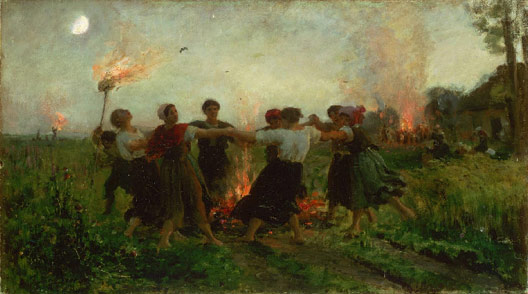Fr : version française / En: english version
Saint John's bonfires
Saint John's bonfires are a Christian adaptation of a very old summer solstice and/or harvest ritual found in various parts of the world, among Celts, Germans, Chinese, Scandinavians, Incans and Turks.
Cats and foxes in the fire
The historian Dulaure left us a description of one such ceremony, which took place under Charles IX:
"A 60-foot-high tree studded with wooden crosspieces to which 500 faggots and 200 rough sticks were attached was set up in the middle of Grève square in front of Paris' town hall; at its foot were piled 10 paths of timber and lots of straw. 120 archers from the town, 100 crossbow-men and 100 arquebusiers were in attendance to contain the crowd. Instrumentalists, especially the kind referred to as a big band, sounding seven trumpets, added to the noise of solemnity. The town's magistrates, provosts and aldermen, carrying yellow wax torches, approached the tree surrounded by logs and bundles, presented the king with a white wax torch embellished with two red velvet handles; and his Majesty, armed with the torch, gravely lit the fire."
The last monarch to light the Grève fire with his own hands was Louis XIV. Later that honor reverted to the provost of the merchants or, in his absence, the aldermen. In a truly bizarre twist, the pole that supported the pile of faggots was topped by a cask or sack full of living cats. An entry in the registries of the city of Paris reads as follows: "Paid to Lucas Pommereux, one of the city's wharf pursers, one hundred "sous parisis" (1/20th of a pound) for furnishing for the three past years to St Jean 1573, all of the cats needed for said fire, as is customary, and even for having provided, a year ago when the king attended, a fox to please His Majesty, and for having furnished a large sack holding said cats." Indeed, it was sometimes the case that, to add to the brilliance of the festival when, perchance, His Majesty attended, some wild animal—a bear, wolf or fox—was added to the cat, the burning of which provided an entertainment of high order...
Excerpt from "Fêtes et coutumes populaires/Popular Festivals and Customs" by Charles Le Goffic, 1911
Communities lit large bonfires and danced around them. Sometimes young men leapt over the flames to show young women how vigorous they were. The fire of Saint John's bonfires apparently symbolizes the sun. Initially fought by the Church, the tradition of joyous fires was so deeply rooted that it endured. After largely falling into disuse in the 20th century, the major popular festival seems to be experiencing a rebirth (from its ashes), especially in Mons, Belgium.





























